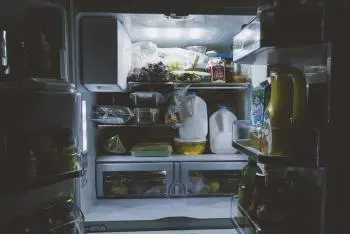
Refrigerators are an essential part of our daily lives. They keep our food fresh and our drinks cold, but sometimes they can present problems, such as the mysterious appearance of water inside them or on the kitchen floor. This phenomenon may be puzzling, but in reality, it has logical explanations.
The thermodynamic operation of a refrigerator is based on the refrigeration cycle, a process that allows heat to be transferred from inside the refrigerator to the outside environment, thus keeping the internal space at a lower temperature than that of the environment. This cycle is made up of four main stages that we will detail in this article.
Below, we will explain the reasons why a refrigerator may leak water and how to solve this problem.
1. Automatic defrosting
The most common cause of a refrigerator leaking water is automatic defrosting. Most modern refrigerators are equipped with a defrosting system that prevents ice buildup in the freezer.
This system periodically defrosts the evaporator coil and drains the water to a drain located at the back or bottom of the refrigerator. If the drain becomes clogged with food, dirt, or ice, water can pool and eventually spill into the refrigerator.
Solution
Regularly clean the drain to prevent blockages. You can do this with a pipe cleaner or flexible wire. Make sure water flows freely into the drain.
2. Condensation tray full
At the back of the refrigerator, below the freezer, there is usually a condensation tray. This tray collects the condensed water that forms during the cooling process. If the tray fills with water, it may spill into the refrigerator.
Solution
Empty the condensation tray regularly. You can access it by removing the rear grill of the refrigerator. Make sure the tray is positioned correctly after emptying it.
3. Water Filter
If your refrigerator is equipped with a water dispensing system or a water filter, the problem may come from a leak in the pipes or a bad connection.
Solution
Check the water filter connections and pipes to make sure they are tight. If you find a leak, replace the damaged part.
4. Ice Container Overflow:
If your refrigerator has an ice maker, the ice bin may become overfilled, causing water to drip into the freezer and then into the refrigerator.
Solution
Make sure you do not overfill the ice container and that the pieces are assembled correctly.
5. Problems with temperature
A refrigerator that does not maintain a proper temperature may experience excessive condensation, which may look like a water leak.
Solution
Check that the refrigerator temperature is set correctly and that the doors are sealed tightly. If the problem persists, you may need to call a technician to check the cooling system.
How does a refrigerator work? The refrigeration cycle
The principle behind its operation is based on a refrigeration cycle that involves the absorption of heat from its interior and the expulsion of that heat to the external environment.
This is achieved through a thermodynamic cycle that involves the following steps:
1. Compression
The cycle begins with a compressor, located at the back or bottom of the refrigerator. The compressor is a motor that compresses a refrigerant gas, usually freon or a similar compound, into a high-pressure, high-temperature state.
Compression is carried out through an adiabatic process, so that when the gas is compressed, the temperature increases.
2. Condensation
Hot, compressed refrigerant gas flows from the compressor to condenser coils located at the back or bottom of the refrigerator. These coils are designed to dissipate heat to the ambient air. When gas cools and condenses, it changes from a gaseous state to a liquid state, releasing heat in the process.
3. Expansion
High pressure and high temperature liquid refrigerant gas is sent through an expansion valve. As the refrigerant passes through this valve, it expands rapidly and its pressure decreases. This causes a drastic drop in temperature and causes the refrigerant to become a low temperature liquid and gas mixture.
4. Evaporation
The refrigerant in a state of low pressure and low temperature enters the evaporator, located inside the refrigerator. Here, the heat from inside the refrigerator is absorbed by the refrigerant.
This heat absorption process causes the refrigerant to evaporate, returning to a gaseous state.
5. Continuous cycle
The refrigerant in a gaseous state returns to the compressor to begin the cycle again. This process repeats continuously while the refrigerator is on.
The refrigerant absorbs heat from inside the refrigerator, carries it to the condenser where it is dissipated to the outside environment, and then returns to the evaporator to repeat the process.
Results
The result of this refrigeration cycle is that the air inside the refrigerator is cooled and maintains a low temperature, thus keeping food fresh and preserving its quality.
Additionally, heat transfer to the outside of the refrigerator is why the area behind or under the refrigerator may feel warm.


